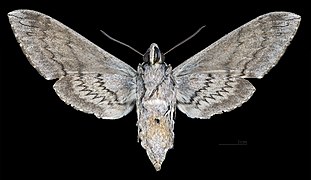Manduca quinquemaculatus
| Manduca quinquemaculatus | ||||||||||||
|---|---|---|---|---|---|---|---|---|---|---|---|---|

Manduca quinquemaculata |
||||||||||||
| Systematics | ||||||||||||
|
||||||||||||
| Scientific name | ||||||||||||
| Manduca quinquemaculatus | ||||||||||||
| ( Haworth , 1803) |
Manduca Quinquemaculata is a butterfly ( moth ) from the family of moth (Sphingidae).
features
The moths have a fore wing length of 52 to 57 millimeters. The species can easily be confused with Manduca sexta . However, it does not have a brownish, but a greyish basic color. On the forewings the animals have a pale, fairly straight, grayish-white band from the anal angle to about half of the outer edge, on which an even black line runs parallel. M. sexta has a jagged white band in its place. On the thorax , M. sexta is colored brown, M. quinquemaculatus has a lighter colored thorax, the tegulae are dark colored. The color and pattern of the species are not variable.
The caterpillars often coexist with those of the similar species. They have seven pairs of sloping, white side stripes, which are not, however, bordered by dark. They also do not extend back to the next body segment. In addition, each stripe under the stigmas is connected with a horizontal stripe and the two stripes together form a characteristic "V".
The pupa is red-brown and has a smooth surface. As with M. sexta , it has a protruding, free proboscis sheath. The Kremaster is quite short and has a double top.
Occurrence
The species is the most widespread hawk species in North America . It probably occurs in practically all states of the United States, at least as an errant; Evidence from Montana, Wyoming and South Dakota is missing so far. The species is rare in the south. In Canada it occurs in Nova Scotia, south of Québec , in Ontario north to Huntsville , in the southern parts of the Prairie Provinces and in the south from British Columbia to Summerland . Different habitats are settled, which also include agriculturally used areas. In Virginia and North Carolina , the species occurs as a pest on tobacco and tomatoes.
Way of life
The moths hatch during the day, but do not become active until dusk. They are attracted by artificial light sources, where they often occur in large numbers. The adults are important pollinators and have been identified in pink Catharanthe ( Catharanthus roseus ), Lonicera japonica , petunias ( Petunia ), common soapwort ( Saponaria officinalis ), flame flowers ( Phlox ), hook lilies ( Crinum ), Nicotiana obtusifolia , Nicotiana attenuata and Agave parryiata .
Flight and caterpillar times
The moths fly in the north and south-west of their range in one generation in July and August. In Virginia and North Carolina as well as west along the lower Mississippi Valley and south to the Rio Grande Valley, they appear to fly in two generations in spring and fall.
Food of the caterpillars
For a long time the nightshade family (Solanaceae) was the only food plant of the species. In eastern North America, for example, the caterpillars often eat tomatoes ( Solanum lycopersicum ) and Virginian tobacco ( Nicotiana tabacum ). In the southwest you can find it on various nightshades ( Solanum ), large-flowered thorn apple ( Datura innoxia ) and Nicotiana obtusifolia . Recently, however, a population of Kallstroemia parviflora from the zygophyllaceae family has been discovered in Arizona .
development
The females lay their eggs individually on the top and bottom of the leaves of the food plants. The caterpillars rest on the midrib on the underside of the leaf and also feed in this position. Pupation takes place a few centimeters deep in the ground in a cave.
supporting documents
Individual evidence
- ↑ a b c d e f g h James P. Tuttle: The Hawkmoths of North America, A Natural History Study of the Sphingidae of the United States and Canada. The Wedge Entomological Research Foundation, Washington, DC 2007, ISBN 978-0-9796633-0-7 .
- ↑ Danny Kessler and Ian T. Baldwin: Making sense of nectar scents: the effects of nectar secondary metabolites on floral visitors of Nicotiana attenuata . In: The Plant Journal , Volume 49, 2006. pp. 840-854. doi : 10.1111 / j.1365-313X.2006.02995.x
literature
- James P. Tuttle: The Hawkmoths of North America, A Natural History Study of the Sphingidae of the United States and Canada. The Wedge Entomological Research Foundation, Washington, DC 2007, ISBN 978-0-9796633-0-7 .




